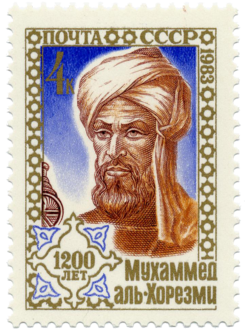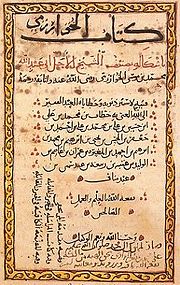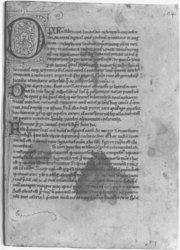
Muḥammad ibn Mūsā al-Khwārizmī
Background Information
This selection is made for schools by a children's charity read more. SOS Children is the world's largest charity giving orphaned and abandoned children the chance of family life.
| Muhammad ibn Mūsā al-Khwārizmī | |
|---|---|
 A stamp issued September 6, 1983 in the Soviet Union, commemorating al-Khwārizmī's (approximate) 1200th birthday. |
|
| Born | c. 780 |
| Died | c. 850 |
Al-Khwarizmi (Muḥammad ibn Mūsā al-Khwārizmī محمد بن موسى الخوارزمي) was a Persian Islamic mathematician, astronomer, astrologer and geographer. He was born around 780 in Khwārizm (now Khiva, Uzbekistan) and died around 850. He worked most of his life as a scholar in the House of Wisdom in Baghdad.
His Algebra was the first book on the systematic solution of linear and quadratic equations. Consequently he is considered to be the father of algebra, a title he shares with Diophantus. Latin translations of his Arithmetic, on the Indian numerals, introduced the decimal positional number system to the Western world in the 12th century. He revised and updated Ptolemy's Geography as well as writing several works on astronomy and astrology.
His contributions not only made a great impact on mathematics, but on language as well. The word algebra is derived from al-jabr, one of the two operations used to solve quadratic equations, as described in his book.
Etymology
The words algorism and algorithm stem from Algoritmi, the Latinization of his name. (In Finnish the term for algorithm is just that, "algoritmi".) His name is also the origin of the Spanish word guarismo and of the Portuguese word algarismo, both meaning digit.
Life
Few details about al-Khwārizmī's life are known; it is not even certain where he was born. His name indicates he might have come from Khwarezm (Khiva), then part of Greater Khorasan, the eastern part of the territory of Persia, in the Abbasid empire, now Xorazm Province of Uzbekistan.
His kunya is given as either Abū ʿAbd Allāh (Arabic: أبو عبد الله) or Abū Jaʿfar (أبو جعفر in Arabic).
The historian al-Tabari gave his name as Muhammad ibn Musa al-Khwārizmī al-Majousi al-Katarbali (Arabic: محمد بن موسى الخوارزميّ المجوسيّ القطربّليّ). The epithet al-Qutrubbulli indicates he might instead have come from Qutrubbull, a small town near Baghdad. Regarding al-Khwārizmī's religion, Toomer writes:
Another epithet given to him by al-Ṭabarī, "al-Majūsī," would seem to indicate that he was an adherent of the old Zoroastrian religion. This would still have been possible at that time for a man of Iranian origin, but the pious preface to al-Khwārizmī's Algebra shows that he was an orthodox Muslim, so al-Ṭabarī's epithet could mean no more than that his forebears, and perhaps he in his youth, had been Zoroastrians.
In Ibn al-Nadīm's Kitāb al-Fihrist we find a short biography on al-Khwārizmī, together with a list of the books he wrote. Al-Khwārizmī accomplished most of his work in the period between 813 and 833. After the Islamic conquest of Persia, Baghdad became the centre of scientific studies and trade, and many merchants and scientists from as far as China and India traveled to this city—as such apparently so did Al-Khwārizmī. He worked in Baghdad as a scholar at the House of Wisdom established by Caliph al-Maʾmūn, where he studied the sciences and mathematics, which included the translation of Greek and Sanskrit scientific manuscripts.
Contributions
His major contributions to mathematics, astronomy, astrology, geography and cartography provided foundations for later and even more widespread innovation in algebra, trigonometry, and his other areas of interest. His systematic and logical approach to solving linear and quadratic equations gave shape to the discipline of algebra, a word that is derived from the name of his 830 book on the subject, al-Kitab al-mukhtasar fi hisab al-jabr wa'l-muqabala (Arabic الكتاب المختصر في حساب الجبر والمقابلة) or: "The Compendious Book on Calculation by Completion and Balancing". The book was first translated into Latin in the twelfth century.
His book On the Calculation with Hindu Numerals written about 825, was principally responsible for the diffusion of the Indian system of numeration in the Middle-East and then Europe. This book also translated into Latin in the twelfth century, as Algoritmi de numero Indorum. From the name of the author, rendered in Latin as algoritmi, originated the term algorithm.
Some of his contributions were based on earlier Persian and Babylonian Astronomy, Indian numbers, and Greek sources.
Al-Khwārizmī systematized and corrected Ptolemy's data in geography as regards to Africa and the Middle east. Another major book was his Kitab surat al-ard ("The Image of the Earth"; translated as Geography), which presented the coordinates of localities in the known world based, ultimately, on those in the Geography of Ptolemy but with improved values for the length of the Mediterranean Sea and the location of cities in Asia and Africa.
He also assisted in the construction of a world map for the caliph al-Ma'mun and participated in a project to determine the circumference of the Earth, supervising the work of 70 geographers to create the map of the then "known world".
When his work was copied and transferred to Europe through Latin translations, it had a profound impact on the advancement of basic mathematics in Europe. He also wrote on mechanical devices like the astrolabe and sundial.
Algebra
al-Kitāb al-mukhtaṣar fī ḥisāb al-jabr wa-l-muqābala (Arabic: الكتاب المختصر في حساب الجبر والمقابلة “The Compendious Book on Calculation by Completion and Balancing”) is a mathematical book written approximately 830 CE.
The word algebra is derived from the name of one of the basic operations with equations (al-jabr) described in this book. The book was translated in Latin as Liber algebrae et almucabala by Robert of Chester ( Segovia, 1145) hence "algebra", and also by Gerard of Cremona. A unique Arabic copy is kept at Oxford and was translated in 1831 by F. Rosen. A Latin translation is kept in Cambridge.
Al-Khwārizmī's method of solving linear and quadratic equations worked by first reducing the equation to one of six standard forms (where b and c are positive integers)
- squares equal roots (ax² = bx)
- squares equal number (ax² = c)
- roots equal number (bx = c)
- squares and roots equal number (ax² + bx = c)
- squares and number equal roots (ax² + c = bx)
- roots and number equal squares (bx + c = ax²)
by dividing out the coefficient of the square and using the two operations al-ǧabr (Arabic: الجبر “restoring” or “completion”) and al-muqābala ("balancing"). Al-ǧabr is the process of removing negative units, roots and squares from the equation by adding the same quantity to each side. For example, x² = 40x - 4x² is reduced to 5x² = 40x. Al-muqābala is the process of bringing quantities of the same type to the same side of the equation. For example, x²+14 = x+5 is reduced to x²+9 = x.
Several authors have published texts under the name of Kitāb al-ǧabr wa-l-muqābala, including Abū Ḥanīfa al-Dīnawarī, Abū Kāmil (Rasāla fi al-ǧabr wa-al-muqābala), Abū Muḥammad al-ʿAdlī, Abū Yūsuf al-Miṣṣīṣī, Sind ibn ʿAlī, Sahl ibn Bišr (author uncertain), and Sharaf al-Dīn al-Ṭūsī.
Arithmetic
Al-Khwārizmī's second major work was on the subject of arithmetic, which survived in a Latin translation but was lost in the original Arabic. The translation was most likely done in the 12th century by Adelard of Bath, who had also translated the astronomical tables in 1126.
The Latin manuscripts are untitled, but are commonly referred to by the first two words with which they start: Dixit algorizmi ("So said al-Khwārizmī"), or Algoritmi de numero Indorum ("al-Khwārizmī on the Hindu Art of Reckoning"), a name given to the work by Baldassarre Boncompagni in 1857. The original Arabic title was possibly Kitāb al-Jamʿ wa-l-tafrīq bi-ḥisāb al-Hind ("The Book of Addition and Subtraction According to the Hindu Calculation")
Geography
Al-Khwārizmī's third major work is his Kitāb ṣūrat al-Arḍ (Arabic: كتاب صورة الأرض "Book on the appearance of the Earth" or "The image of the Earth" translated as Geography), which was finished in 833. It is a revised and completed version of Ptolemy's Geography, consisting of a list of 2402 coordinates of cities and other geographical features following a general introduction.
There is only one surviving copy of Kitāb ṣūrat al-Arḍ, which is kept at the Strasbourg University Library. A Latin translation is kept at the Biblioteca Nacional de España in Madrid. The complete title translates as Book of the appearance of the Earth, with its cities, mountains, seas, all the islands and rivers, written by Abu Ja'far Muhammad ibn Musa al-Khwārizmī, according to the geographical treatise written by Ptolemy the Claudian.
The book opens with the list of latitudes and longitudes, in order of " weather zones", that is to say in blocks of latitudes and, in each weather zone, by order of longitude. As Paul Gallez points out, this excellent system allows us to deduce many latitudes and longitudes where the only document in our possession is in such a bad condition as to make it practically illegible.
Neither the Arabic copy nor the Latin translation include the map of the world itself, however Hubert Daunicht was able to reconstruct the missing map from the list of coordinates. Daunicht read the latitudes and longitudes of the coastal points in the manuscript, or deduces them from the context where they were not legible. He transferred the points onto graph paper and connected them with straight lines, obtaining an approximation of the coastline as it was on the original map. He then does the same for the rivers and towns.
Astronomy
Al-Khwārizmī's Zīj al-sindhind (Arabic: زيج "astronomical tables of Sind and Hind") is a work consisting of approximately 37 chapters on calendrical and astronomical calculations and 116 tables with calendrical, astronomical and astrological data, as well as a table of sine values. This is one of many Arabic zijes based on the Indian astronomical methods known as the sindhind.
The original Arabic version (written c. 820) is lost, but a version by the Spanish astronomer Maslama al-Majrīṭī (c. 1000) has survived in a Latin translation, presumably by Adelard of Bath (January 26, 1126). The four surviving manuscripts of the Latin translation are kept at the Bibliothèque publique (Chartres), the Bibliothèque Mazarine (Paris), the Bibliotheca Nacional (Madrid) and the Bodleian Library (Oxford).
Jewish calendar
Al-Khwārizmī wrote several other works including a treatise on the Hebrew calendar (Risāla fi istikhrāj taʾrīkh al-yahūd "Extraction of the Jewish Era"). It describes the 19-year intercalation cycle, the rules for determining on what day of the week the first day of the month Tishrī shall fall; calculates the interval between the Jewish era (creation of Adam) and the Seleucid era; and gives rules for determining the mean longitude of the sun and the moon using the Jewish calendar. Similar material is found in the works of al-Bīrūnī and Maimonides.
Other works
Several Arabic manuscripts in Berlin, Istanbul, Tashkent, Cairo and Paris contain further material that surely or with some probability comes from al-Khwārizmī. The Istanbul manuscript contains a paper on sundials, which is mentioned in the Fihirst. Other papers, such as one on the determination of the direction of Mecca, are on the spherical astronomy.
Two texts deserve special interest on the morning width (Maʿrifat saʿat al-mashriq fī kull balad) and the determination of the azimuth from a height (Maʿrifat al-samt min qibal al-irtifāʿ).
He also wrote two books on using and constructing astrolabes. Ibn al-Nadim in his Kitab al-Fihrist (an index of Arabic books) also mentions Kitāb ar-Ruḵāma(t) (the book on sundials) and Kitab al-Tarikh (the book of history) but the two have been lost.






